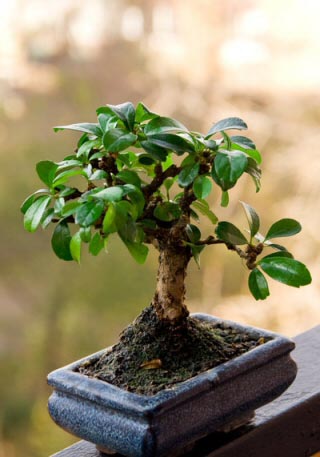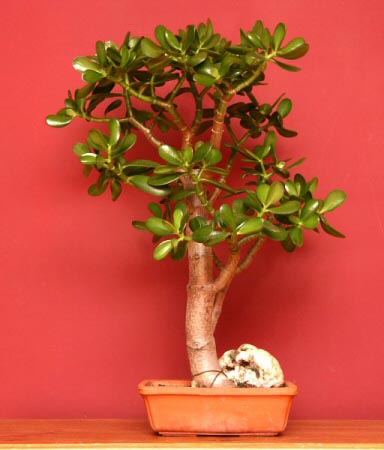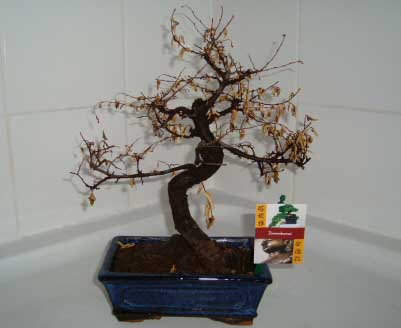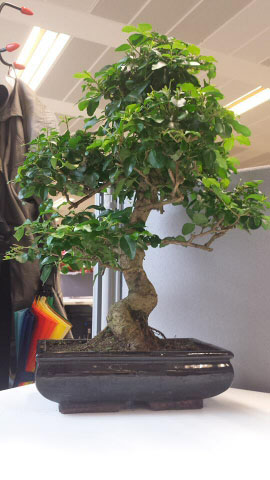





The word bonsai simply means a "plant in a tray". Being defined as - "The art of growing dwarfed, ornamentally shaped trees or shrubs in small shallow pots or trays".  The tradition originated in Japan before spreading to many parts of the world, however Indoor Bonsais are a much newer concept and it's believed to have started in Germany before spreading outwards to many different countries. This means because there are both Outdoor Bonsai and Indoor Bonsai the care and treatment of the plants is quite different.
The tradition originated in Japan before spreading to many parts of the world, however Indoor Bonsais are a much newer concept and it's believed to have started in Germany before spreading outwards to many different countries. This means because there are both Outdoor Bonsai and Indoor Bonsai the care and treatment of the plants is quite different.
Outdoor Bonsai are, as the name suggests, plants which belong outside. They are the plants we have growing in our gardens and yards, sometimes 100 times as big as the one in the Bonsai tray. You can bring them inside for a few days at a time, perhaps as a center piece for a party, but afterwards they must be returned to the garden otherwise within a few weeks they will have weakened and will gradually die.
Indoor Bonsai are "normal" houseplants which have been grown in the Bonsai style - that is they have been miniaturised. Common plants selected for this are Crassula ovata (Jade Plant), Punica granatum (Pomegranate), Ficus benjamin (Weeping Fig) and Sageretia theezans (Fukien Tea). Careful pruning, training and keeping the plants in a small tray restricts their growth but still allows you to shape and control their appearance. It's often a very rewarding and enjoyable hobby, especially if you want to try something a bit different and more challenging than normal indoor gardening.  The Golden Rule to remember is that when it comes to Bonsai the basic rules of horticulture need to be learnt before you can successfully maintain your tree.
The Golden Rule to remember is that when it comes to Bonsai the basic rules of horticulture need to be learnt before you can successfully maintain your tree.
The two most common mistakes that will eventually end up costing you the entire plant are: One - buying an Outdoor Bonsai and attempting to keep it as a permanent house guest. Two - not watering the plant enough. Good, well cared for Bonsais are not cheap to buy, they have taken considerable effort and time to reach their saleable size and appearance. So to avoid disappointment we would strongly advise you research up on the topic, and while this article will give you a good introduction there is still a wealth of advanced knowledge out there that is worth searching for.
A cheap Bonsai should be looked at very carefully, it will either be in poor condition or it will be very young with little training and styling. Of course if you have researched up on the subject you will be able to shape the young plant into something wonderful, although it may take several years before you get there. If you can't wait then you always have the option of buying from a Bonsai specialist, prices will be considerably more but you will have the "perfect" tree from the start,
As you may expect because we are a website about houseplants from here on we ditch Outdoor Bonsai and focus solely on Indoor Bonsai (mostly).
Light
Most Indoor Bonsai require a brightly lit spot. A few will accept direct sunlight but because of the watering demands covered below and as you will not usually want a great deal of growth, a bright spot is almost always enough.
Watering
If you are able to, use rainwater.  That said, it's much more important to water regularly and frequently, in some cases this can (but won't always) be daily. Be sure the entire root ball is evenly moist and not just the soil surface. The plant needs moisture at its roots to survive. Do not let the compost dry out fully at any time. The photo on the right shows the consequences of this.
That said, it's much more important to water regularly and frequently, in some cases this can (but won't always) be daily. Be sure the entire root ball is evenly moist and not just the soil surface. The plant needs moisture at its roots to survive. Do not let the compost dry out fully at any time. The photo on the right shows the consequences of this.
The small container combined with the large amount of leaf surface area means the plant will transpire and use the limited water available rapidly. If temperatures are very warm, humidity is low or the container is too small, the need for water will increase.
Although you may be tempted to saturate the plant or let it sit in water to compensate, don't. As with all other houseplants too much water is just as bad as too little. A Bonsai demands that it's owner is attentive to its watering needs and requirements.
The plant needs moisture at its roots to survive. Do not let the compost dry out at any time.
Humidity
Frequent or daily misting of the leaves is helpful as this increases the humidity and therefore reduces the rate of transpiration i.e. you need to water less. If the humidity is very low, perhaps because you are using air conditioning then it's essential that you explore ways to increase it.
Feeding
It's important to feed Bonsais as their need for nutrients is greater because the tray in which they sit is unnaturally small and the compost contains very little sustenance for the plant. Feed only sparingly in Winter and for the rest of the year follow general fertilizing rules for houseplants.
Temperature
The average Bonsai Tree requires the warmth of a standard home for much of the year. You don't need to employ anything fancy, just ensure it isn't positioned in a place which receives direct harsh sunlight, such as in a South facing window. In the cooler months of the year an unheated room is absolutely fine, but avoid very low temperatures.
Repotting
How you approach the subject of repotting will depend on your long term goals. If you are happy with the size of the plant you have then there is no need to repot into a bigger tray. If you are attempting to sculpt and grow a much larger specimen then it will eventually become necessary.
In either case, it's necessary to root prune a healthy plant every now and again and to replace the compost with new. This involves taking the plant out of the pot and gently freeing some of the roots, you should then prune some of these away, around 1/4 or 1/3 of the total root ball. Afterwards you replace the newly created space with fresh compost. Normal potting compost is not suitable here, so look to buy ready-mixed Bonsai compost, which tends to be coarse but highly absorbent. There is no real need to do this more frequently than once a year at most.
Propagation
 It's not usual to try and propagate Indoor Bonsai, however there is no reason why you can't. Remember they are almost always "normal" houseplants just grown on a much smaller scale, so the usual propagation for the sister version can be applied, for example by leaf cuttings.
It's not usual to try and propagate Indoor Bonsai, however there is no reason why you can't. Remember they are almost always "normal" houseplants just grown on a much smaller scale, so the usual propagation for the sister version can be applied, for example by leaf cuttings.
Speed of Growth
Bonsai Tree's will typically grow slowly, however in the majority of cases this is what you want.
Height / Spread
Coming in many shapes and sizes it's not realistic to give you a height or spread guide because the possible variation is so huge.
Flowers
Only a few Indoor Bonsais are grown with flowers in mind. It's much more popular to come across flowering Bonsais when they are grown outdoors.
Anything Else?
There is lots about Bonsai growing that we haven't been able to cover here. So stay tuned for a more extensive Bonsai Tree Growing Guide.
Copyright © www.100flowers.win Botanic Garden All Rights Reserved